The other day, I trekked up to 55 Columbia St. E. in Waterloo to check out TD Bank Group’s new facility for technology advancement.
When I reached the door and peered inside, I wondered if I was in the right place. It looked more like an upscale urban cocktail lounge than a corporate office.
Of course, that’s the whole point, as TD pushes boldly ahead in its mission to reimagine banking in an age of instant mobile communication and hyperconnectivity.
As one of Canada’s biggest banks, with $1.1 trillion in assets as of July 31, TD is understandably eager to stay ahead of the curve on innovation as it continues to serve (and grow) its base of 24 million global customers – in other words, to “walk and chew gum at the same time,” as Silicon Valley sage Steve Blank describes it.
This thinking is at the core of Communitech’s corporate innovation model, as recently laid out in this space by CEO Iain Klugman.
This week, as the bank marks the first anniversary of the TD Lab – the startup-like innovation space it opened in the Communitech Hub a year ago – it is also celebrating the deepening of its local innovation footprint via the new Waterloo facility.
As the occasion approached, I met Ian McDonald, Director of TD Lab, at 55 Columbia, where we sat in a pub-like booth and talked about the bank’s successful first year in the Communitech Hub, along with the growth of its tech-related activities in Waterloo Region.
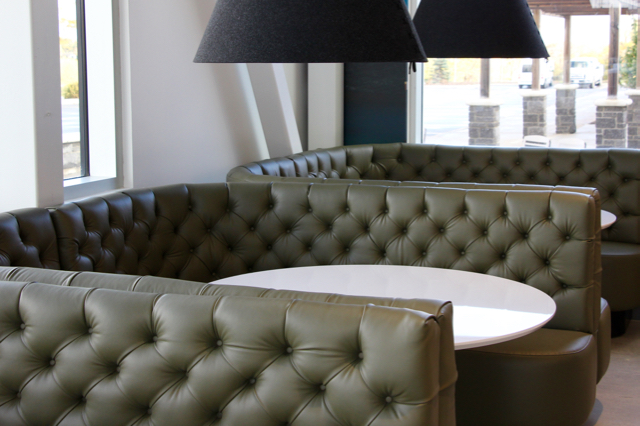
Parts of TD’s new technology centre in Waterloo have the feel of an upscale lounge.
(Communitech photo: Anthony Reinhart)
Here's how our conversation went:
Q – Can you believe it’s been a year already?
A – It is remarkable that it’s been a year – for many different reasons.
When I think of the number of prototypes we’ve built, the number of startups we’ve engaged with, the number of co-op students we’ve worked with, and the number of TD employees who have visited the lab and our ideation bootcamps – which is where they learn some of the methodologies we use, like lean startup and design thinking – it is hard to believe it’s only been a year.
Q – What can you tell us about some of those numbers?
A – In the first year, we’ve built 25 proof-of-concepts and prototypes.
We’ve also engaged with over 50 startup companies, and a number of those discussions have continued within the larger TD organization. It can be hard for startups to find the right person to talk to, and develop a relationship with, so in a way the lab can be a front door to make a connection.
We’ve had over 500 TD employees visit us at the lab, and at our current pace we’ll very likely see another 500 in the next six months.
We’re in our fourth co-op term, and two-thirds of my team are co-op students – almost 40 of them have come through the lab experience so far.
Another measure is our engagement with the community. We've sponsored a number of Communitech programs, like women in technology, an investment that we fully support.
We also helped sponsor Startup Weekend Waterloo Region, and were a gold sponsor of Hack the North along with Andreessen Horowitz. So, it was a really interesting position to have the two brands next to each other.
Q – What can you tell us about some of those 25 prototypes your team worked on during the first year?
A – Due to the nature of what we’re doing, we can’t talk about all of them, and really, that’s the spirit of the lab, too – a lot of what we’ve built won’t go to market.
Exploration and prototyping are our main goals, to build something that makes the product vision and customer experience real, so we can further test it with customers. We don’t build prototypes for the code; we build them so that we can validate and improve the ideas, which is a lean startup philosophy. We intentionally fail fast and learn fast.
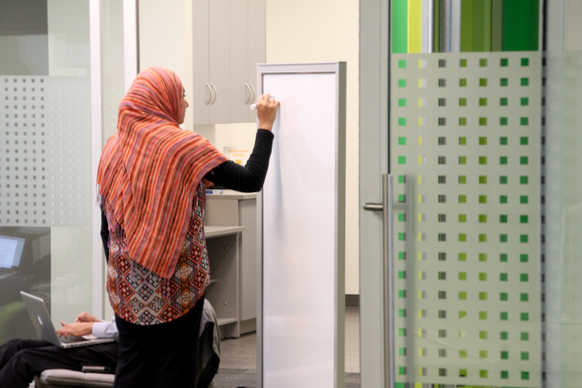
Whiteboards abound in TD’s new technology centre in Waterloo, where 120 people will
be working a year from now. (Communitech photo: Anthony Reinhart)
When we bring the prototypes back to TD, they may be commercialized as we envisioned them, or they may serve as an inspiration for the organization to do something different.
Or maybe the most important transition is the lessons that we’ve learned about the customer, even, which have applications far outside the prototype that we’ve created.
We have two examples that we've talked about publicly. One of them we called a ‘comfort test,’ which was about connecting mobile and branch experiences.
We used the inspiration of a flash mob to set the test up in an unexpected location to create a delightful experience. We tested the prototypes live with customers in the branch to get their raw feedback.
The other one is more recent: it’s an app called Family Allowance, available in the Google Play store, as a public beta. The app is all about kid-friendly financial education.
This was inspired by a need that parents articulated to us. They were looking for tools to teach their kids effective saving behaviours.
What we have is very much like a startup ecosystem, where you have incubators and accelerators. Think about our team at the Hub like an idea incubator. We’re also starting to do more solutions acceleration like we did with Family Allowance. This is one of the areas we’ll grow, including a team here (at 55 Columbia) to do some of that work, to complement what the other team at the Hub is doing.
With Family Allowance, TD asked, can you take this further? Is this something we can experiment with in-market?
So we started with a private beta, but now it’s live and public and anyone can give us feedback. That’s how we’ll validate the ideas and continue to improve.
Q – How challenging has it been to branch out on the look and feel of these prototypes?
A – The whole spirit of the lab, and why TD made the investment, was to explore ways of thinking and doing things differently.
While the larger organization is thinking about creating exceptional experiences for current customer needs, we can act in a path-finding role and look a bit further forward.
So, it makes sense for us, in that path-finding role, to operate more like a startup company. I describe it as lean, creative and experimental.
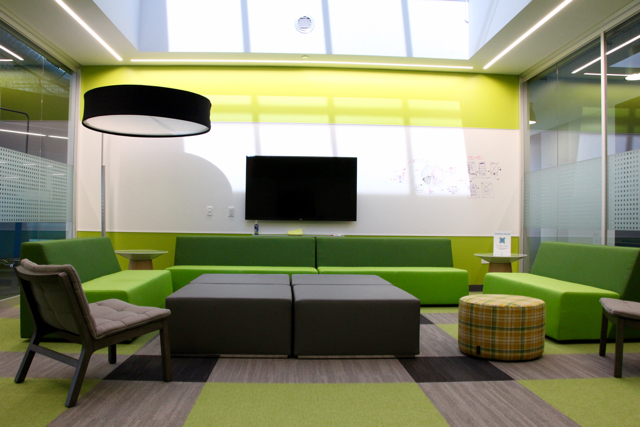
Natural light and vibrant colours dominate the creative workspaces at TD’s new
technology centre in Waterloo. (Communitech photo: Anthony Reinhart)
And now we’re extending that even further and saying, ‘What does it mean to do that and actually bring things to market?’
That’s why in the lab, when we take things to market, it is different. When you see Family Allowance, it has the TD shield but it also says ‘brought to you by TD Lab.’
We’re not necessarily targeting the average TD customer, either. We’re looking at customers who place a higher priority on digital – the early adopters – and we’re engaging with them to help inform what the solution might look like in the future, if TD was to commercialize it.
Again, we have a fail-fast, learn-fast mentality. So we may test something in market and not bring it forward. We’ll make the decision based on customer feedback.
Q – In other words, this is the Steve Blank model of the ambidextrous organization, where a company continues to use existing methods of serving customers, while at the same time going out and path-finding, as you put it.
A – It’s exactly that thinking.
Q – How has the lab itself evolved in its first year, in the way it approaches its work?
A – There are a couple of different views on that. One is, the more investment we put in, the more we get out, so it’s been a continual process of engaging more and more with the community.
Hack the North was a really great signpost this year. Having TD among the startup companies, with the hackers, it was a phenomenal event and completely student-organized. We loved everything about being a part of it.
The program itself, and how we do things in the lab, has also evolved over that time frame.
We explore solutions and technology, but we also explore methodologies in the same path-finding role; try them out, see what works and what doesn’t work, and share all of those lessons with the larger organization.
That’s why we run innovation bootcamps for TD visitors. We started them as a workshop to help the co-op students get up to speed on our design and development process. And then we tried it with employees, and it resonated extremely well.
A few TD teams have taken parts of that process and made them part of their core delivery streams, such as doing early design work and iteration before you actually set any requirements for a project.
We have our own lab development process on a wall in the lab on a whiteboard, because we change it regularly with feedback. That model has probably gone through a dozen or more iterations since we started.
Q – We’re sitting in a facility that will soon house 120 employees. Connect the dots between the lab at the Hub and the decision to open this new facility in Waterloo.
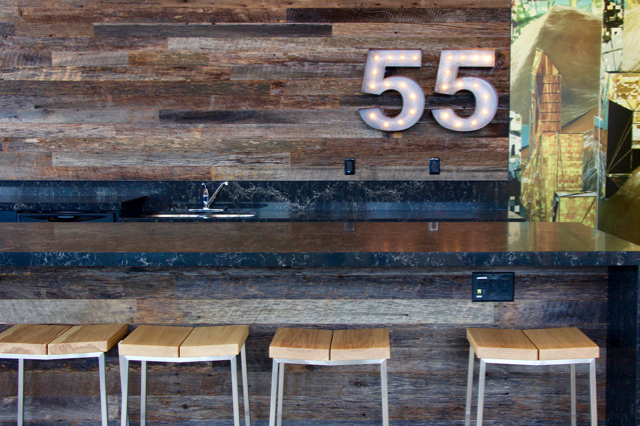
Barstools line the counter in the front reception area of TD’s new technology centre at
55 Columbia St. E. in Waterloo. (Communitech photo: Anthony Reinhart)
A – If you want to do the type of work that we’re doing in the lab, at a time when TD is also increasingly investing in digital, you need to be where these new ideas and advanced technologies are being explored. And that’s happening here in Waterloo Region.
Talent is critical, and we have three world-class undergrad and graduate campuses locally, so we can attract talent to the TD lab from the local campuses, but also from across Ontario and beyond.
We’ve hired 10 to 12 co-op students every term, almost 40 students now in a variety of roles and programs. Some of those students may transition to the larger TD organization out of the lab space, but all will have had an exceptional experience with TD.
The other thing is innovation culture. It’s harder to quantify, but you do see the results; I mean, the attention in the U.S., the success of Waterloo startups through programs like Y Combinator and the C100 and others. But you can also feel it; that sense of community that we have in the tech ecosystem here, and that desire for really positive collaboration.
Q – How will this facility differ from the lab at the Tannery?
A – It’s important that the lab team we have stays at the Hub. We’re there to interact with startups in the ecosystem, and I see us continuing to improve on that.
And then the larger organization, in this new dynamic and creative workspace, I would think about it as a mobile and web centre of excellence. It’s about unleashing technical and creative talent to help improve digital experiences across the bank.
One of the things we continue to tell people, although there’s a much better appreciation of it now that we’ve been in this space for a while, is that there is a technology company at the heart of TD. There are 8,500 technology employees in the bank; it’s just that they’re not the visible thing people see when they see the brand.
The lab and the new centre are proof points of how seriously TD takes innovation.
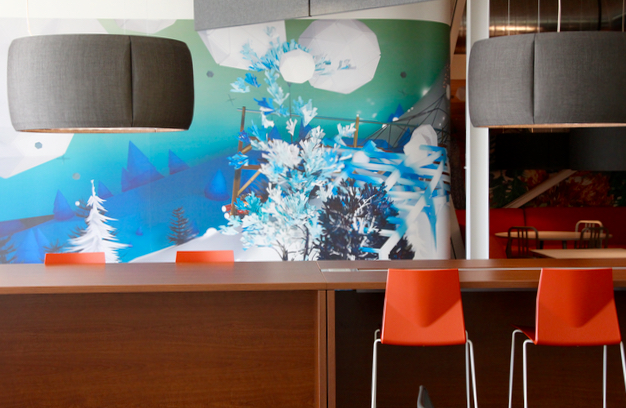
Cubicles are a rare species inside TD’s new technology centre in
Waterloo. (Communitech photo: Anthony Reinhart)
Q – What does the future look like for TD’s innovation activities in Waterloo Region?
A – I think this new facility, on a larger scale, will bolster awareness in Waterloo Region and beyond, of TD’s serious intent around technology and innovation.
The other thing that will continue and expand is customer engagement. TD is all about knowing the customer, and creating comfortable digital experiences. We’re all part of the same team; the lab is just another way we bring value to customers.
Q – Do you feel different working within the bank after a year of these activities?
A – Yes, I do.
I talk about the innovation culture you can see in our projects, but also the processes we follow, and most importantly in the people in the lab.
I’m so optimistic about how positively TD employees have engaged with us, their interest in seeing what we’re doing, and using it to apply to their own work.
We act as a kind of lighthouse for that innovation culture within TD, and outwardly to the tech community.
Anthony Reinhart is Communitech’s Director of Editorial Strategy and senior staff writer. View from the ‘Loo looks at the issues, people and events that shape Waterloo Region’s technology sector.

